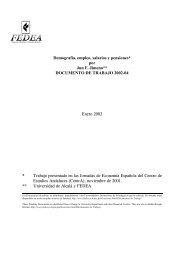The Evolution of Retirement by J. Ignacio Conde-Ruiz* Vincenzo ...
The Evolution of Retirement by J. Ignacio Conde-Ruiz* Vincenzo ...
The Evolution of Retirement by J. Ignacio Conde-Ruiz* Vincenzo ...
Create successful ePaper yourself
Turn your PDF publications into a flip-book with our unique Google optimized e-Paper software.
t +1andr is the interest rate.<br />
To account for differences in the wages <strong>by</strong> age, i.e., between young and adult<br />
workers, and for economic growth, we characterize the relations between wages<br />
across time and generations as follows: wt+1 a =(1+g) wt a ,whereg is the real<br />
growth rate <strong>of</strong> wages, and w y t<br />
= ϕw a t ,whereϕ defines the ratio between the<br />
wage <strong>of</strong> young and adult workers at time t.<br />
To simplify the analysis, we assume that agents only value life-time income<br />
— or analogously old age consumption, c t+2 — and leisure when young and adult,<br />
according to the following utility function, which has been introduced in a two<br />
periods context <strong>by</strong> Casamatta, Cremer and Pestieau (2002) and Cremer and<br />
Pestieau (2002) to study incentive effects on early retirement provisions:<br />
U (l t ,z t+1 ,c t+2 )=c o t+2 − l2 t<br />
2α wy t − z2 t+1<br />
2γ wa t+1 (2)<br />
where the second and third terms represent the disutility from the effective<br />
labor supply, and α and γ are parameters that quantify the relative importance<br />
<strong>of</strong> leisure when young and adult, and that we take to be equal respectively to<br />
α =1/ (1 + r) 2 and γ =1/ (1 + r). 4<br />
Hence, a young agent at time t and an adult at time t+1 maximize eq. 2 with<br />
respect to l t and z t+1 subject to the budget constraints at eq. 1. <strong>The</strong> solution<br />
<strong>of</strong> the two maximization problems yields the following optimal individual labor<br />
supply decisions:<br />
b lt = 1− τ t (3)<br />
bz t+1 = 1− τ t+1 (4)<br />
We consider a balanced budget pay as you go (PAYG) social security system,<br />
where the sum <strong>of</strong> all pension transfers is equal the sum <strong>of</strong> all contributions. Since<br />
pensions are awarded to elderly individuals only, whereas young and adults<br />
4 <strong>The</strong>se assumptions simplify the analysis. However the main results qualitatively hold true<br />
in more general cases.<br />
9






